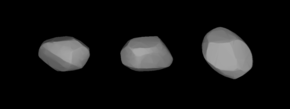80 Sappho
 Lightcurve-based 3D-model of Sappho | |
| Discovery | |
|---|---|
| Discovered by | N. R. Pogson |
| Discovery site | Madras Obs. |
| Discovery date | 2 May 1864 |
| Designations | |
| (80) Sappho | |
| Pronunciation | /ˈsæfoʊ/[1] |
Named after | Sappho (Greek poet) |
| main-belt · (inner) | |
| Adjectives | Sapphonian /sæˈfoʊniən/[2] Sapphoian /sæˈfoʊ.iən/[3] |
| Symbol | |
| Orbital characteristics[4] | |
| Epoch 4 September 2017 (JD 2458000.5) | |
| Uncertainty parameter 0 | |
| Aphelion | 2.7544 AU (412.05 Gm) |
| Perihelion | 1.8370 AU (274.81 Gm) |
| 2.2957 AU (343.43 Gm) | |
| Eccentricity | 0.19980 |
| 3.48 yr (1270.5 d) | |
| 287.260° | |
| 0° 17m 0.06s / day | |
| Inclination | 8.676° |
| 218.699° | |
| 139.662° | |
| Earth MOID | 0.843652 AU (126.2085 Gm) |
| Jupiter MOID | 2.7319 AU (408.69 Gm) |
| TJupiter | 3.553 |
| Physical characteristics[4] | |
| 68.563±1.033 km | |
| Mass | (4.6 ± 2.11/0.86)×1017 kg[5] |
Mean density | 3.055 ± 1.400/0.569 g/cm3[5][a] |
| 14.03087[6] h | |
Pole ecliptic latitude | 194°[6] |
Pole ecliptic longitude | −26°[6] |
| 0.206±0.014[4] 0.185 [7] | |
| S-type asteroid | |
| 9.38 to 13.6 | |
| 7.98 | |
80 Sappho (symbol: ![]() )is a large, S-type (stony) main-belt asteroid. It was discovered by English astronomer Norman Pogson on 2 May 1864, and is named after Sappho, the Archaic Greece poet. The asteroid is orbiting the Sun at a distance of 2.2957 AU with a period of 3.48 years and an eccentricity (ovalness) of 0.2. The orbital plane is inclined at an angle of 8.68° to the plane of the ecliptic.[4]
)is a large, S-type (stony) main-belt asteroid. It was discovered by English astronomer Norman Pogson on 2 May 1864, and is named after Sappho, the Archaic Greece poet. The asteroid is orbiting the Sun at a distance of 2.2957 AU with a period of 3.48 years and an eccentricity (ovalness) of 0.2. The orbital plane is inclined at an angle of 8.68° to the plane of the ecliptic.[4]
13-cm radar observations of this asteroid from the Arecibo Observatory between 1980 and 1985 were used to produce a diameter estimate of 83 kilometres (52 mi).[8] Hanuš et al. (2013) confirmed the polar axis has ecliptic coordinates (λ, β) = (194°, −26°) and listed a rotation period of 14.03087 h.[6]
Sappho (at apparent magnitude 11.8) occulted the magnitude 7.2 star HIP 24403 in the constellation of Taurus on 16 September 2018 at 8:54 UT.[9][10] Sacramento and Salt Lake City were the two major cities located underneath the shadow path. Data from this event will help improve the shape model of the asteroid. During the occultation the asteroid was roughly 1.6 AU (240,000,000 km; 150,000,000 mi) from Earth with an uncertainty of ±76 km.
Notes
[edit]- ^ Assuming a diameter of 66 ± 8 km.
References
[edit]- ^ "Sappho". Oxford English Dictionary (Online ed.). Oxford University Press. (Subscription or participating institution membership required.)
- ^ Catherine Hobbs (1995) Nineteenth-century Women Learn to Write
- ^ The Thistle, January 1903, vol. I, no. 2, p. 4
- ^ a b c d "80 Sappho", JPL Small-Body Database Browser, NASA Jet Propulsion Laboratory, archived from the original on 22 September 2014, retrieved 30 March 2013.
- ^ a b Fienga, A.; Avdellidou, C.; Hanuš, J. (February 2020). "Asteroid masses obtained with INPOP planetary ephemerides". Monthly Notices of the Royal Astronomical Society. 492 (1): 589–602. doi:10.1093/mnras/stz3407.
- ^ a b c d Hanuš, J.; et al. (September 2013), "Sizes of main-belt asteroids by combining shape models and Keck adaptive optics observations", Icarus, 226 (1): 1045–1057, arXiv:1308.0446, Bibcode:2013Icar..226.1045H, doi:10.1016/j.icarus.2013.07.023, S2CID 118710558.
- ^ "Asteroid Data Sets". Archived from the original on 17 December 2009. Retrieved 13 January 2007.
- ^ Ostro, S. J.; et al. (August 1985), "Mainbelt asteroids - Dual-polarization radar observations", Science, 229 (4712): 442–446, Bibcode:1985Sci...229..442O, doi:10.1126/science.229.4712.442, PMID 17738665, S2CID 38234273.
- ^ "Interactive GoogleMap of Shadow Path". Archived from the original on 21 February 2018. Retrieved 21 February 2018.
- ^ "(80) Sappho / HIP 24403 event on 2018 Sep 16, 08:54 UT". Archived from the original on 15 September 2017.
External links
[edit]- Shape model for 80 Sappho
- 80 Sappho at AstDyS-2, Asteroids—Dynamic Site
- 80 Sappho at the JPL Small-Body Database
